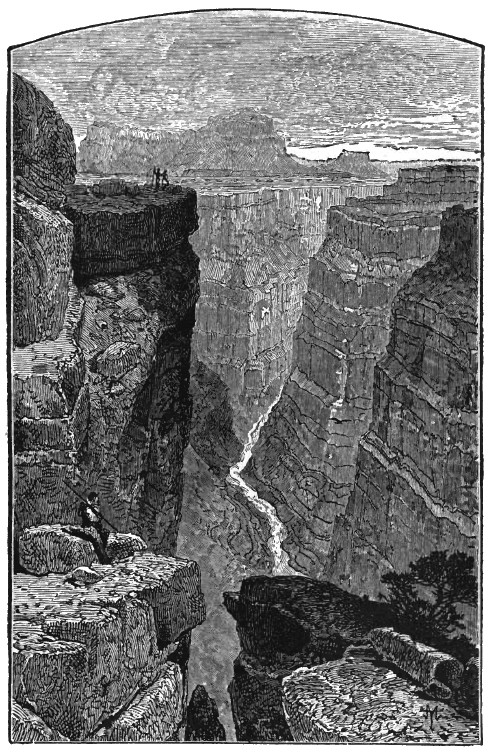In Arizona, the southern division of the
Cordilleran region, there are five important copper districts. The Bisbee;
Clifton-Morenci; Globe; Jerome, and Mineral Creek / Ray.
The Bisbee district: The Bisbee (Warren) district is situated on the
eastern slope of the Mule Mountains and is only a short distance north of
the international boundary with Mexico. This district, which contains the famous Copper Queen Mine, is the
leading copper producing district in the State. Here Paleozoic quartzites
and limestones are resting on pre-Cambrian rocks that were intruded by
granite porphyry and after deep erosion, were buried by Cretaceous
sedimentary rocks, which have in greater part been eroded from the
productive area. The pre-Cambrian rocks are overlain by about 5,000 feet of
Paleozoic limestones. After their deposition they were deformed by folding
and faulting and were cut by intrusions of granitic porphyry of probably
Jurassic Age, which is intimately connected with the origin of the copper
deposits. The principal mass, of which the most prominent point is
Sacramento Hill, close to Bisbee, is about one mile long and 2 miles wide.
The primary copper ores were deposited during or after the intrusion of the granite porphyry and before the deposition of the Cretaceous beds. Deep oxidation and enrichment followed. The primary deposition was connected with contact metamorphism of the limestones, shown by the development of tremolite, diopside, garnet and other silicates, generally in crystals of microscopic size. The ore bodies first worked are those in the Carboniferous and Devonian limestones, but recent developments have discovered lenticular masses of ore in the Cambrian limestone, and disseminated chalcocite copper ore has been found in the porphyry. The ore in limestone is extensively enriched by chalcocitization and much of it is deeply oxidized.
The ores are found in faulted strata, ranging in age from pre-Cambrian to Cretaceous. Often the fault plane forms a boundary for the ore body. The intrusions of a granitic magma have metamorphosed Carboniferous limestones and produced characteristic contact minerals. The ore-bearing solutions have risen from unknown depths and the ores occur as replacement deposits in the limestones. The surface ores were originally sulfides of copper, lead and zinc. These remain unaltered at the lower depths but in the upper portions of the ore bodies the oxygenated ores of copper, cuprite, malachite and azurite appear. The copper deposits lie in the limestones, surrounding crescentlike the east side of the intrusive mass, and appear as irregular and ill-defined or rudely tabular masses, which on the whole follow the dip of the stratification. They are almost entirely oxidized, even down to depths, of 1,400 feet below the surface. The oxidized ore, containing copper carbonates, cuprite, and sometimes also chalcocite, with much limonite, passes gradually on its peripheries into "ledge matter" or limonitic clays, which in turn grade into altered and contact-metamorphosed limestones. The contact metamorphism is unusually inconspicuous, but the limestone surrounding the intrusive mass contains fine-grained tremolite, diopside, garnet, vesuvianite, and quartz, associated with magnetite, pyrite, bornite, and a little chalcopyrite and galena and sphalerite.
The district is cut by numerous faults, and one of these, the Dividend fault, is specially prominent in forming one boundary of the ore-bearing area. This was followed by intrusions of a granite magma forming dikes, sills, or irregular stocks, which have metamorphosed the Carboniferous limestones, with the production of characteristic contact minerals. The Carboniferous limestone forms a shallow basin, which is cut through by the Dividend fault. The principal copper ore bodies lie around the porphyry stock, and along faults and fissureswhere .replacement of the limestone has occurred. Most of the ore has been developed in the Carboniferous and Devonian limestones, though in recent years important bodies have been discovered in the Cambrian, and some even in the granite porphyry. The ore bodies form large, irregularly distributed, but rudely tabular masses. The ore consists of malachite, azurite, cuprite, and other oxidized copper minerals above, which pass at variable depths into unaltered sulfides; but between the two, or at least never far from the effects of oxidation, masses of massive or sooty chalcocite are frequently found. The primary ore consists of pyrite, chalcopyrite, with smaller bodies of galena and some sphalerite, and was deposited by metasomatic replacement of the limestone. As originally formed, the deposits usually contained too little copper to make them commercially valuable, but they have been subsequently enriched by secondary enrichment. Large bodies of primary sulfides of commercial grade have been recently developed. The general relations of these ores to the intrusive porphyry and the contact silicates indicate that they are of contact-metamorphic origin.
In the Oliver shaft, close to the contact, on the 1,200-foot level, the limestone is more intensely metamorphosed than elsewhere and contains bodies of pyrite, mixed with chalcopyrite and bornite. The porphyry dips underneath the limestones and the contact is thus found farther west in the mines than on the surface. The limestones are also cut by a considerable number of dikes. A heavy mantle of pyritic quartzose ore, with some chalcopyrite and chalcocite, surrounds the porphyry, pitching parallel to the contact underneath the limestone of the surface. The deep oxidization of the ores was practically completed before the Cretaceous and under conditions of water level different from those of today. The sericitized and chloritized porphrry contains some large bodies of chalcocite ore. Here, the mineral replaces pyrite.
In some cases an iron gossan has indicated an underlying ore body, but many others do not outcrop. In 1914 the average copper recovery of the Bisbee copper ores was about 5.4 per cent and the average precious metals value about $1.35 per ton of ore. The principal production is derived from the Copper Queen and Calumet & Arizona mines.
Return To: Copper Ore Deposits of the USA

